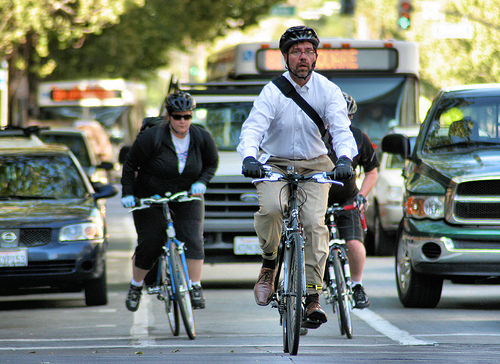 This is the sixth column in a series focusing on the economics of bicycling.
This is the sixth column in a series focusing on the economics of bicycling.
Miles Craig of Portland, Oregon applied for an hourly call center job at movie rental by mail empire Netflix last January. “My phone interview went incredibly well,” he said. “And the lady said, ‘Well, let’s get you in for a face-to-face interview. What time can you come in?'”
Craig mentioned casually that he’d be using a combination of bicycle and transit to get to the interview and, if he got the job, to work.
That was when things started to go downhill. “She got very subdued and said that she ‘was going to have to speak with scheduling about getting you in for a face-to-face’ and that she would get back to me. She never did. I called her twice … the second time it went to voice mail, and I got an email rejection the next day.”
A Netflix representative contacted for this story declined to comment.
Sadly, Craig’s experience isn’t unheard of. Bike-commuting job seekers do sometimes run up against a usually unspoken requirement that they own a car, even for jobs that don’t require driving.
But as bike commute trips continue to rise nationwide, many employers are catching on to the benefits they can gain by actually encouraging employees to bike to work. Some are even shelling out cold, hard cash in an effort to boost their ranks of bike commuters.
It shouldn’t be a surprise. A Dutch study last year found that cycle commuters provide their employers with an economic advantage by requiring fewer sick days each year and enjoying better overall health.
Other research has shown that bike commuters are happier and less stressed than those who drive or take transit. At rush hour, your bicycling employees may get to work faster and with fewer unexpected delays.
Perhaps most quantifiably, bike commuting employees don’t require nearly the same amount of investment in parking — even when employers invest in deluxe, secure bike parking facilities.
OHSU, a teaching hospital in a hilly section of Portland hemmed in by narrow roads and expensive real estate, is acutely attuned to all the benefits of a bicycling workforce. They’ve seen bike trips “skyrocket” since they began handing out a $50 cash incentive for every 30 days of bike commuting an employee logs. (As of 2009, the federal government allows employers to offer a $20 monthly bike-commuting credit as a fringe benefit. You can learn more about the somewhat confusing program here.)
Fortunately, there are many more ways to create a bike-friendly environment at work.
Advocates at the League of American Bicyclists have set out to tabulate these, creating a Bike Friendly Business ranking system. Business applicants are ranked on a range of practices, from providing bike maps to keeping a company bike fleet on hand for errands during the workday. Points are even given for big-picture factors like being in a location that is accessible by bike-friendly routes.
Companies that aren’t sure where to begin can make use of the LAB’s technical resource guides for everything from bike parking best practices to skills training programs for new riders.
Indoor, secure bike parking with lockers, showers, and changing rooms are the traditional hallmark of a bike-friendly workplace. These amenities can be essential for employees in suburban offices who must look professional after commuting long distances in extreme weather. Several companies go a step further, responding to employee demand by providing dry cleaning pickup and dropoff services so that bicycling employees can skip the once-a-week car commute to restock their supply of fresh suits.
Workplace culture matters as much as investment or facilities, though. Companies without the space and money to invest in parking and locker rooms can often simply let staff bring their bikes into their offices. On the other hand, there’s no infrastructure money can buy that can make up for a manager, coworker, or corporate standards predisposed to disapprove of your commute mode.
 On the way to work in San Jose. Photo: Richard MasonerThe best strategies seem to be ones that are demanded and even created by bicycling employees themselves, which is one reason bike commute challenges seems to be so universally effective at normalizing bicycling and even producing new bike commuters. Whether run by advocacy groups or internally, these friendly competitions provide incentives for people to learn from each other about how to make use of whatever bicycling infrastructure and resources are available.
On the way to work in San Jose. Photo: Richard MasonerThe best strategies seem to be ones that are demanded and even created by bicycling employees themselves, which is one reason bike commute challenges seems to be so universally effective at normalizing bicycling and even producing new bike commuters. Whether run by advocacy groups or internally, these friendly competitions provide incentives for people to learn from each other about how to make use of whatever bicycling infrastructure and resources are available.
Some of the most powerful ways a business can encourage employees to ride to work have nothing to do with bicycling.
Let’s take another look at Netflix. The company has a much-lauded policy of allowing employees to work whatever hours they like and take as many days off as they need, so long as they continue to excel at their job.
Such policies, and the company cultures they create, can be invaluable to workers who want to skip rush hour, take their bikes on less crowded trains, head off on focus-enhancing lunchtime rides, or simply commute fewer days per week.
So why would this company balk at hiring a bike commuter? Miles Craig applied for an hourly job; it seems that Netflix only offers its famous flexibility to salaried workers.
We’re fortunate that more and more companies are starting to see past the old prejudices against bicycling and notice the bottom line benefits of encouraging employees — all of them — to ride.



